Information injection-pump assembly
ZEXEL
101405-3060
1014053060
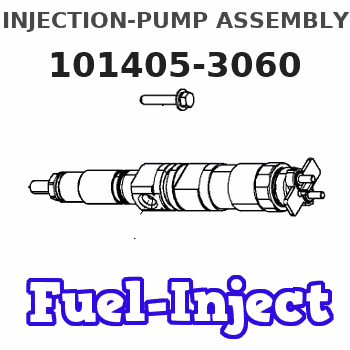
Rating:
Cross reference number
ZEXEL
101405-3060
1014053060
Zexel num
Bosch num
Firm num
Name
101405-3060
INJECTION-PUMP ASSEMBLY
Calibration Data:
Adjustment conditions
Test oil
1404 Test oil ISO4113 or {SAEJ967d}
1404 Test oil ISO4113 or {SAEJ967d}
Test oil temperature
degC
40
40
45
Nozzle and nozzle holder
105780-8140
Bosch type code
EF8511/9A
Nozzle
105780-0000
Bosch type code
DN12SD12T
Nozzle holder
105780-2080
Bosch type code
EF8511/9
Opening pressure
MPa
17.2
Opening pressure
kgf/cm2
175
Injection pipe
Outer diameter - inner diameter - length (mm) mm 6-2-600
Outer diameter - inner diameter - length (mm) mm 6-2-600
Overflow valve
131424-3420
Overflow valve opening pressure
kPa
255
221
289
Overflow valve opening pressure
kgf/cm2
2.6
2.25
2.95
Tester oil delivery pressure
kPa
157
157
157
Tester oil delivery pressure
kgf/cm2
1.6
1.6
1.6
Direction of rotation (viewed from drive side)
Right R
Right R
Injection timing adjustment
Direction of rotation (viewed from drive side)
Right R
Right R
Injection order
1-3-4-2
Pre-stroke
mm
2.5
2.45
2.55
Beginning of injection position
Drive side NO.1
Drive side NO.1
Difference between angles 1
Cal 1-3 deg. 90 89.5 90.5
Cal 1-3 deg. 90 89.5 90.5
Difference between angles 2
Cal 1-4 deg. 180 179.5 180.5
Cal 1-4 deg. 180 179.5 180.5
Difference between angles 3
Cyl.1-2 deg. 270 269.5 270.5
Cyl.1-2 deg. 270 269.5 270.5
Injection quantity adjustment
Adjusting point
A
Rack position
10.7
Pump speed
r/min
1175
1175
1175
Average injection quantity
mm3/st.
85.5
84.5
86.5
Max. variation between cylinders
%
0
-2.5
2.5
Basic
*
Fixing the lever
*
Boost pressure
kPa
48.7
48.7
Boost pressure
mmHg
365
365
Hydraulic cylinder ON
*
Injection quantity adjustment_02
Adjusting point
C
Rack position
8.5+-0.5
Pump speed
r/min
400
400
400
Average injection quantity
mm3/st.
9
8
10
Max. variation between cylinders
%
0
-15
15
Fixing the rack
*
Boost pressure
kPa
0
0
0
Boost pressure
mmHg
0
0
0
Hydraulic cylinder ON
*
Injection quantity adjustment_03
Adjusting point
D
Rack position
-
Pump speed
r/min
100
100
100
Average injection quantity
mm3/st.
85
85
95
Fixing the lever
*
Boost pressure
kPa
0
0
0
Boost pressure
mmHg
0
0
0
Hydraulic cylinder OFF
*
Rack limit
*
Boost compensator adjustment
Pump speed
r/min
800
800
800
Rack position
R1-0.75
Boost pressure
kPa
28
28
28
Boost pressure
mmHg
210
210
210
Boost compensator adjustment_02
Pump speed
r/min
800
800
800
Rack position
R1(10.7)
Boost pressure
kPa
38
34
42
Boost pressure
mmHg
285
255
315
Test data Ex:
Governor adjustment
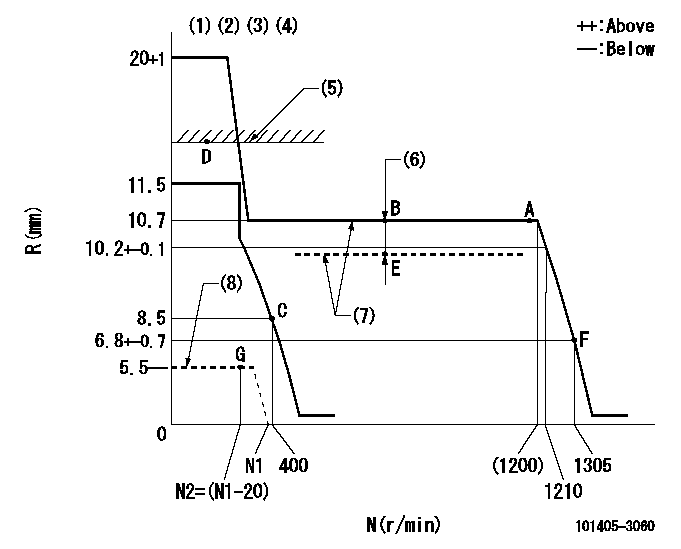
N:Pump speed
R:Rack position (mm)
(1)Target notch: K
(2)Tolerance for racks not indicated: +-0.05mm.
(3)The torque control spring does not operate.
(4)Adjust the secondary timing before adjusting the governor.
(5)RACK LIMIT (When hydraulic cylinder is OFF)
(6)Boost compensator stroke: BCL
(7)When hydraulic cylinder ON: P1
(8)Stop lever at stopping (with the stop lever at full)
----------
K=12 BCL=0.75+-0.1mm P1=((392)kPa,(4)kgf/cm2)
----------
----------
K=12 BCL=0.75+-0.1mm P1=((392)kPa,(4)kgf/cm2)
----------
Speed control lever angle
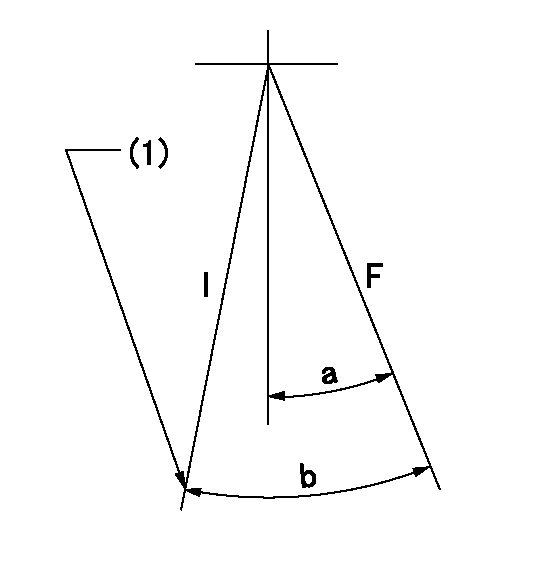
F:Full speed
I:Idle
(1)Stopper bolt setting
----------
----------
a=(15deg)+-5deg b=(24deg)+-5deg
----------
----------
a=(15deg)+-5deg b=(24deg)+-5deg
Stop lever angle
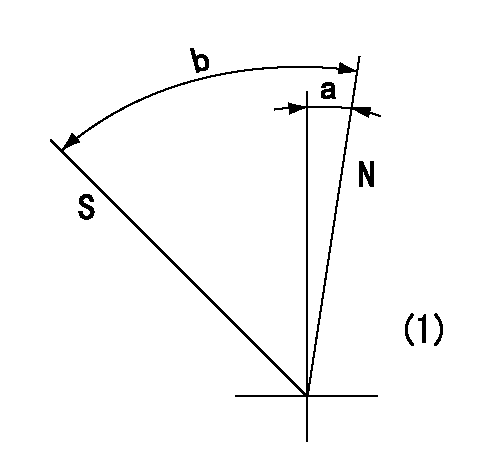
N:Pump normal
S:Stop the pump.
(1)No return spring
----------
----------
a=0deg+-5deg b=53deg+-5deg
----------
----------
a=0deg+-5deg b=53deg+-5deg
Timing setting
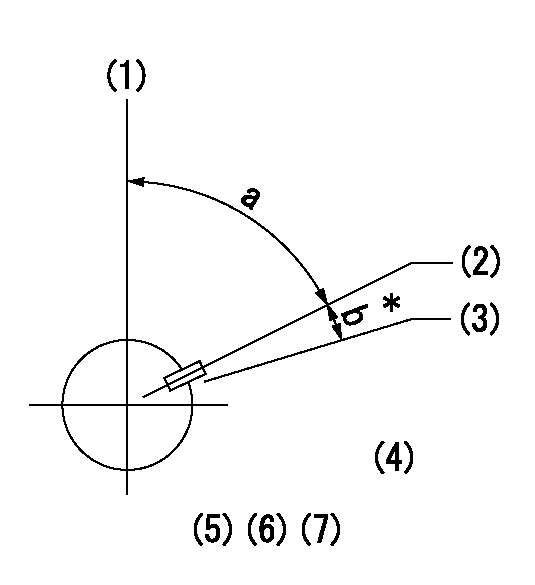
(1)Pump vertical direction
(2)Key groove position at No. 1 cylinder's beginning of injection position (at BTDC: aa).
(3)Position of the key groove of the No. 1 cylinder at B.T.D.C. bb (fix the governor flyweight at this position for delivery).
(4)B.T.D.C.: aa
(5)At second timing adjustment, set the camshaft at the * position and tighten the flyweight locknut.
(6)Align the flyweight's timing gear position with the lockpin groove and then fully tighten the flyweight to the camshaft.
(7)Remove the lock pin and adjust the governor. Reinstall the lock pin to fix the flyweight for delivery.
----------
aa=14deg bb=0deg
----------
a=54deg54min+-3deg b=7deg+-30min
----------
aa=14deg bb=0deg
----------
a=54deg54min+-3deg b=7deg+-30min
Information:
Operating Cost Information
The term "Life Cycle Costs" can be defined as the sum of the individual costs experienced by an engine from the day of purchase until the day of retirement. In other words, the total Owning and Operating Costs.Owning Costs are fixed costs such as initial purchase price, interest on borrowed money, depreciation and taxes.Operating Costs are a combination of fixed and variable costs such as fuel, oil, operator expenses, road taxes, tires, chassis maintenance and repair, permits, licenses, engine maintenance and repair and downtime.The difference between revenues generated and Life Cycle Costs (total Owning and Operating Costs) is profit.Caterpillar and your Caterpillar dealer cannot guarantee that you will make a profit. However, Caterpillar and your Caterpillar dealer can provide you with a variety of services that can help you reduce the costs that impact your profits.An Engine Operating Cost Analysis is a service provided by your dealer that was developed by Caterpillar to help you reduce the Life Cycle Cost of your engine.More specifically, an Engine Operating Cost Analysis is a computerized program that examines existent and expectant oil, fuel, maintenance, minor repair, overhaul and downtime costs for the period of time you expect to own the engine. It also calculates the operating cost per mile (km), hour or day.This useful tool provides your dealer with the specific information needed to develop a customized Maintenance Management program for your operation which will minimize your engine's operating costs.Before a cost analysis can be performed, your dealer needs to gather as much information as possible about your operation. He will need to know the length of time you plan to keep your engine/vehicle, your average cost of fuel and oil as well as a variety of other ownership and cost related facts and figures.Once this information is obtained, your dealer will enter the data into an established computerized program to produce an Engine Operating Cost Analysis printout reflecting your current and projected operating costs per mile (km), hour or day.The typical printout of the Engine Operating Cost Analysis program has up to four engine scenarios which can be run at one time. The printout is divided into three major areas:* General Information* Engine Operating Information* Operating Cost SummaryThe General Information section contains basic user data such as name, business, location, ownership, usage per year, etc., information.The Engine Operating Information section is divided into eight subsections that address fuel consumption, oil consumption, preventive maintenance, component repairs such as water pumps, turbochargers, air compressors, etc., before failure repairs, after failure repairs, user's revenue rate per hour and lastly, miscellaneous costs such as operator wages, insurance premiums, etc.Current and expected cost information reflected in the Engine Operating Information section is based on the data provided by you. These are the costs that affect your engine's operating cost.Engine Operating Cost Summary
The Operating Cost Summary section is exactly what it implies, a summary. Here the total dollar expense and percentage of the total operating expense is calculated for each of the eight subsections
The term "Life Cycle Costs" can be defined as the sum of the individual costs experienced by an engine from the day of purchase until the day of retirement. In other words, the total Owning and Operating Costs.Owning Costs are fixed costs such as initial purchase price, interest on borrowed money, depreciation and taxes.Operating Costs are a combination of fixed and variable costs such as fuel, oil, operator expenses, road taxes, tires, chassis maintenance and repair, permits, licenses, engine maintenance and repair and downtime.The difference between revenues generated and Life Cycle Costs (total Owning and Operating Costs) is profit.Caterpillar and your Caterpillar dealer cannot guarantee that you will make a profit. However, Caterpillar and your Caterpillar dealer can provide you with a variety of services that can help you reduce the costs that impact your profits.An Engine Operating Cost Analysis is a service provided by your dealer that was developed by Caterpillar to help you reduce the Life Cycle Cost of your engine.More specifically, an Engine Operating Cost Analysis is a computerized program that examines existent and expectant oil, fuel, maintenance, minor repair, overhaul and downtime costs for the period of time you expect to own the engine. It also calculates the operating cost per mile (km), hour or day.This useful tool provides your dealer with the specific information needed to develop a customized Maintenance Management program for your operation which will minimize your engine's operating costs.Before a cost analysis can be performed, your dealer needs to gather as much information as possible about your operation. He will need to know the length of time you plan to keep your engine/vehicle, your average cost of fuel and oil as well as a variety of other ownership and cost related facts and figures.Once this information is obtained, your dealer will enter the data into an established computerized program to produce an Engine Operating Cost Analysis printout reflecting your current and projected operating costs per mile (km), hour or day.The typical printout of the Engine Operating Cost Analysis program has up to four engine scenarios which can be run at one time. The printout is divided into three major areas:* General Information* Engine Operating Information* Operating Cost SummaryThe General Information section contains basic user data such as name, business, location, ownership, usage per year, etc., information.The Engine Operating Information section is divided into eight subsections that address fuel consumption, oil consumption, preventive maintenance, component repairs such as water pumps, turbochargers, air compressors, etc., before failure repairs, after failure repairs, user's revenue rate per hour and lastly, miscellaneous costs such as operator wages, insurance premiums, etc.Current and expected cost information reflected in the Engine Operating Information section is based on the data provided by you. These are the costs that affect your engine's operating cost.Engine Operating Cost Summary
The Operating Cost Summary section is exactly what it implies, a summary. Here the total dollar expense and percentage of the total operating expense is calculated for each of the eight subsections
Have questions with 101405-3060?
Group cross 101405-3060 ZEXEL
Komatsu
Komatsu
Komatsu
Komatsu
101405-3060
INJECTION-PUMP ASSEMBLY